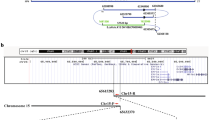Summary
d-Amino acid oxidase cDNA was amplified by a polymerase chain reaction using RNA extracted from the mouse kidney. When digested withHindIII, the cDNAs of the BALB/c and ddY/DAO− mice were cleaved into two fragments whereas the cDNA of the ddY/DAO+ mice was not. Sequencing revealed that nucleotide-471 of the cDNAs was G in the BALB/c and ddY/DAO− mice whereas it was substituted for C in the ddY/DAO+ mice. This base substitution was the cause of the failure of the cleavage of the cDNA of the ddY/DAO+ mice.
Examination of other strains of inbred mice showed thatd-amino-acid oxidase cDNAs of A/J, AKR, C57BL/6, CD-1, CF#1, ICR, DBA/2, NZB and NZW mice were cleaved withHindIII into two fragments whereas those of C3H/He, CBA/J and NC mice were not. Genomic DNAs extracted from the mice of these 15 strains were digested withHindIII and hybridized withd-amino-acid oxidase cDNA. A 18.2-kb fragment hybridized with the probe in the C3H/He, CBA/J, ddY/DAO+ and NC mice whereas two fragments of 12 kb and 6.2 kb hybridized in the other mice. These results are consistent with those of the cDNAs, confirming the loss of theHindIII cleavage site in the C3H/He, CBA/J, ddY/DAO+ and NC mice. The Southern hybridization revealed a loss of a differentHindIII cleavage site in the A/J, AKR, C57BL/6, DBA/2, ICR and NZB mice.
The substitution at nucleotide-471 should cause a substitution of an amino acid residue. However, this substitution did not affect catalytic activity ofd-amino acid oxidase.
Similar content being viewed by others
References
Chomczynski P, Sacchi N (1987) Single-step method of RNA isolation by acid guanidinium thiocyanate-phenol-chlorofrom extraction. Anal Biochem 162: 156–159
Feinberg AP, Vogelstein B (1983) A technique for radiolabeling DNA restriction endonuclease fragments to high specific activity. Anal Biochem 132: 6–13
Fukui K, Miyake Y (1992) Molecular cloning and chromosomal localization of a human gene encodingd-amino acid oxidase. J Biol Chem 267: 18631–18638
Fukui K, Watanabe F, Shibata T, Miyake Y (1987) Molecular cloning and sequence analysis of cDNAs encoding porcine kidneyd-amino acid oxidase. Biochemistry 26: 3612–3618
Graff RJ, Snell GD (1969) Histocompatibility genes of mice. Transplantation 8: 861–876
Heston WE, Vlahakis G, Tsubura Y (1964) Strain DD, a new high mammary tumor strain, and comparison of DD with strain C3H. J Natl Cancer Inst 32: 237–251
Hilgers J, Arends J (1985) A series of recombinant inbred strains between BALB/cHeA and STS/A mouse strains. Curr Top Microbiol Immunol 122: 31–37
Konno R, Yasumura Y (1983) Mouse mutant deficient ind-amino acid oxidase activity. Genetics 103: 277–285
Konno R, Yasumura Y (1984) Brain and kidneyd-amino acid oxidases are coded by a single gene in the mouse. J Neurochem 42: 584–586
Konno R, Yasumura Y (1992)d-Amino-acid oxidase and its physiological function. Int J Biochem 24: 519–524
Konno R, Niwa A, Yasumura Y (1989) Linkage of theDao-1 gene ford-amino-acid oxidase to thePgm-1 gene for phosphoglucomutase-1 on the mouse chromosome 5. Jpn J Genet 64: 341–345
Konno R, Oowada T, Ozaki A, Iida T, Niwa A, Yasumura Y, Mizutani T (1993) Origin ofd-alanine present in urine of mutant mice lackingd-amino-acid oxidase activity. Am J Physiol 265: G699-G703
Krebs HA (1935) CXCVII. Metabolism of amino-acids. III. Deamination of amino-acids. Biochem J 29: 1620–1644
Lowry OH, Rosebrough NJ, Farr AL, Randall RJ (1951) Protein measurement with the Folin phenol reagent. J Biol Chem 193: 265–275
Meister A (1965) Biochemistry of the amino acids, vol 1, 2nd edn. Academic Press, New York, pp 297–304
Momoi K, Fukui K, Watanabe F, Miyake Y (1988) Molecular cloning and sequence analysis of cDNA encoding human kidneyd-amino acid oxidase. FEBS Lett 238: 180–184
Momoi K, Fukui K, Tada M, Miyake Y (1990) Gene expression ofd-amino acid oxidase in rabbit kidney. J Biochem 108: 406–413
Ronchi S, Minchiotti L, Galliano M, Curti B, Swenson RP, Williams CH Jr, Massey V (1982) The primary structure ofd-amino acid oxidase from pig kidney. II. Isolation and sequence of overlap peptides and the complete sequence. J Biol Chem 257: 8824–8834
Sambrook J, Fritsch EF, Maniatis T (1989) Molecular cloning: a laboratory manual, 2nd edn. Cold Spring Harbor Laboratory Press, New York
Sanger F, Nicklen S, Coulson AR (1977) DNA sequencing with chain-terminating inhibitors. Proc Natl Acad Sci USA 74: 5463–5467
Sasaki M, Konno R, Nishio M, Niwa A, Yasumura Y, Enami J (1992) A single-base-pair substitution abolishesd-amino-acid oxidase activity in the mouse. Biochim Biophys Acta 1139: 315–318
Southern EM (1975) Detection of specific sequences among DNA fragments separated by gel electrophoresis. J Mol Biol 98: 503–517
Staats J (1980) Standardized nomenclature for inbred strains of mice: seventh listing. Cancer Res 40: 2083–2128
Tada M, Fukui K, Momoi K, Miyake Y (1990) Cloning and expression of a cDNA encoding mouse kidneyd-amino acid oxidase. Gene 90: 293–297
Author information
Authors and Affiliations
Rights and permissions
About this article
Cite this article
Konno, R., Sasaki, M., Enami, J. et al. Loss ofHindIII cleavage sites in thed-amino acid oxidase gene in some inbred strains of mice. Amino Acids 8, 97–107 (1995). https://doi.org/10.1007/BF00806548
Received:
Accepted:
Issue Date:
DOI: https://doi.org/10.1007/BF00806548




